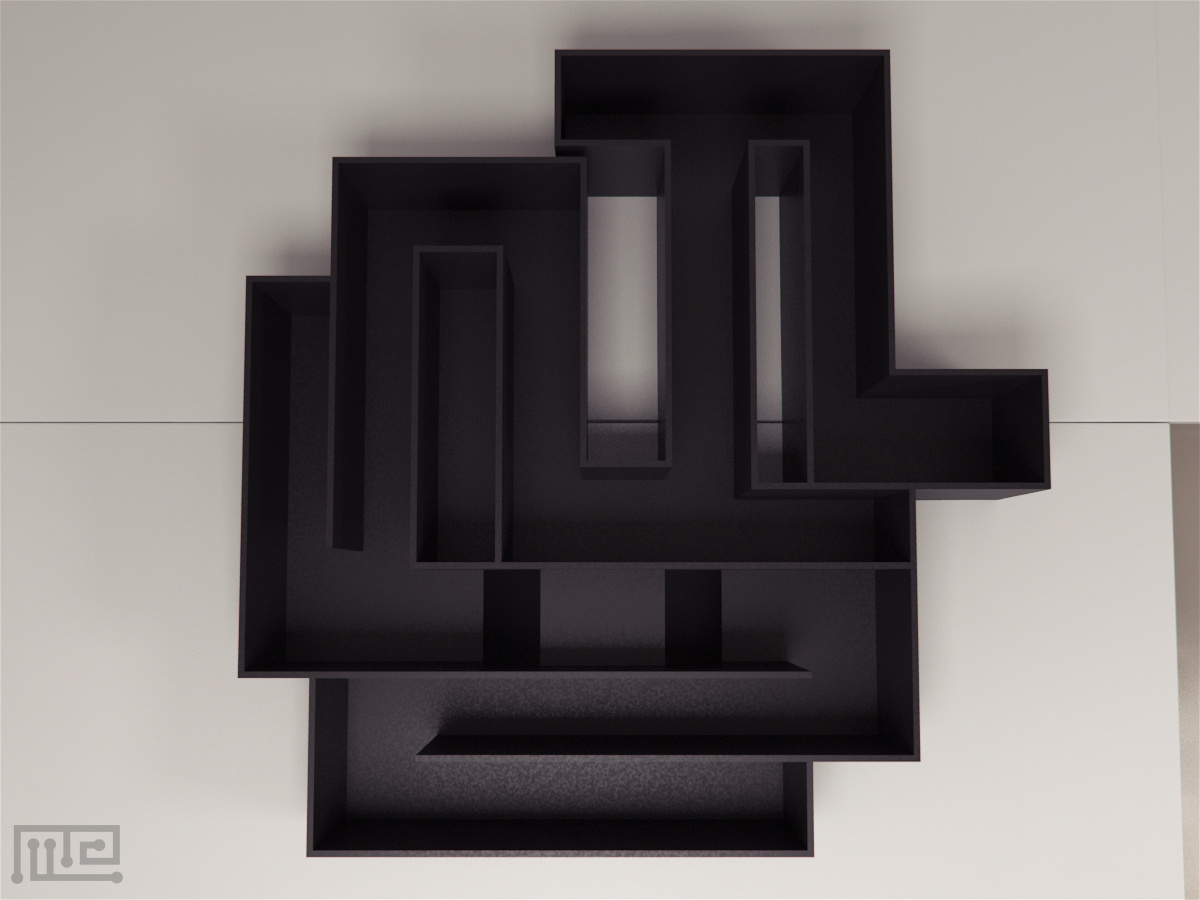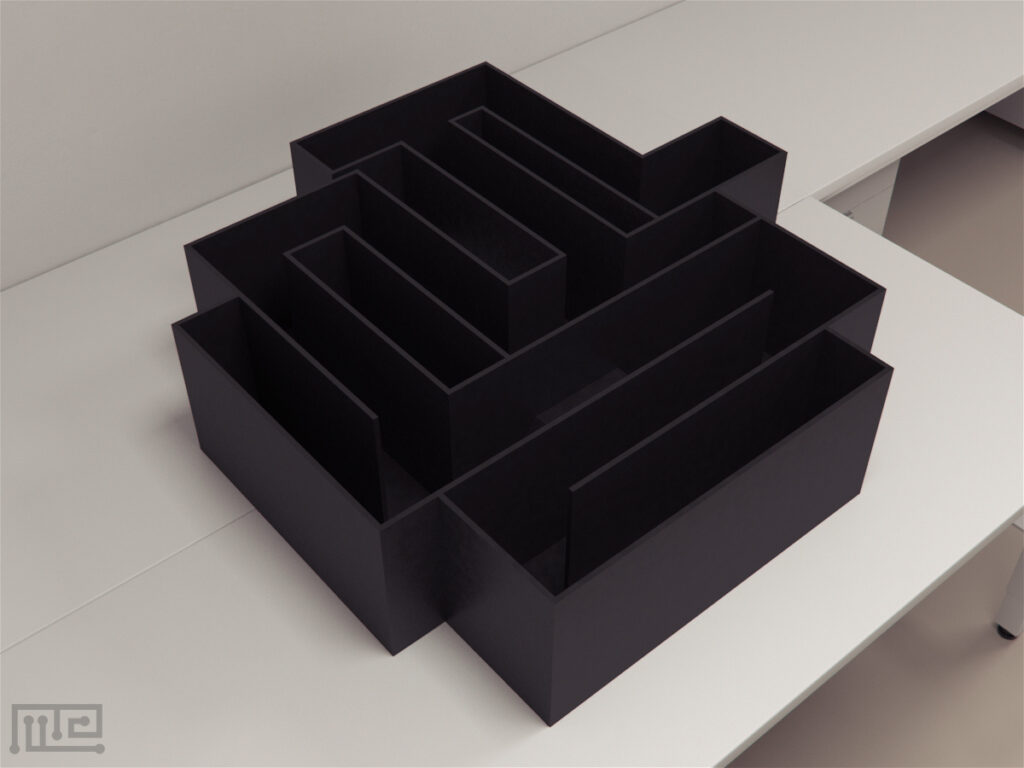The modified Biel maze is used to assess spatial learning and memory in rodents. It is an adaptation of a classical water maze developed by Biel (1940) to study egocentric navigation in rodents (see also Cincinnati maze).
The maze is a labyrinthine maze consisting of lanes with walls and floor made up of opaque acrylic material. The walls are 30 cm high, and the maze lanes vary in length between 50 cm to 1100 cm long. The maze environment is equipped with three tunnels, a ramp platform, cul-de-sacs, left and right turns. Additionally, guillotine doors can also be introduced into the maze to control the animal’s movements.
Mazeengineers offer the Modified Biel-Maze.
Price & Dimensions
Mouse
$ 1890
+S&HHeight of maze walls: 30cmLength of maze lanes: 50cm to 1100cm
Rat
$ 1990
+S&HHeight of maze walls: 40cmLength of maze lanes: 67cm to 1466cm
Documentation
Introduction
The modified Biel maze is used to assess spatial learning and memory in rodents. It is an adaptation of a classical water maze developed by Biel (1940) to study egocentric navigation in rodents (see also Cincinnati maze). The modified Biel maze involves lanes of varying length and dead ends, movements in which are based upon the subject’s cognitive and exploratory characteristics. The modified Biel maze can also be used for the investigation of allocentric and egocentric navigation task performances in rodents.
Exposure to teratogens, drugs, repeated stress, and brain lesions act as triggering factors for varying behavioral deficits and neuro-developmental disorders in humans as well as animals. The modified Biel Maze serves as a powerful apparatus to differentiate between normal and disease animal models by evaluating motivation to explore the maze arena, learning and memory impairments in a modified Biel maze task. Other than evaluating the effect of teratogens and brain lesions, the modified Biel maze can be used to assess problem-solving skills, decision making, exploratory behavior and genetics of abnormal gene expression that lead to decreased cognitive abilities in the rodents.
The modified Biel maze is a labyrinthine maze with a series of left or right turns, lanes with various lengths, and dead ends. Automated guillotine doors can be installed inside the maze arena to control the movement of the subject in the maze task. Visual cues or auditory cues can also be added to the maze arena to adapt it to different experimental protocols. Other apparatuses used to evaluate the spatial learning and memory in rodents includes the Radial Arm Maze, Morris Water Maze, Hebb Williams, and Barnes Maze.
Apparatus and Equipment
The modified Biel maze is a labyrinthine maze consisting of lanes with walls and floor made up of opaque acrylic material. The walls are 30 cm high, and the maze lanes vary in length between 50 cm to 1100 cm long. The maze environment is equipped with three tunnels, a ramp platform, cul-de-sacs, left and right turns. Additionally, guillotine doors can also be introduced into the maze to control the animal’s movements.
Training Protocol
Remove the traces of food and other unwanted contaminants such as feces and urine from the central platform of the maze arena. Ensure the maze is thoroughly cleaned prior to trials to avoid interference from unnecessary cues which can influence the maze performance. For automatic tracking and recording of the subject’s behavior and locomotor activity, a video tracking system such as Noldus EthoVision XT can be used.
Habituation and pre-training
Prior to testing, acclimatize the subjects to the maze arena by allowing them to undergo habituation run for 15 minutes. During the pre-training session give food rewards to the subjects
and introduce additional stimuli inside the maze to promote corporeal activity and exploration.
Modified Biel-maze task
Bait the end position of maze with food reward and remove other cues and tunnels previously used during pre-training. Place the subject in the start position and allow it to explore the maze. Allow the subject to consume the rewards once it finds it. Repeat the procedure for each of the animals on a 2 trial per day basis for approximately 20 days.
Evaluation of the effects of prenatal ethanol teratogenicity on guinea pigs spatial learning and memory
Dobson et al. (2012) investigated the spatial learning and memory deficits of ethanol teratogenicity in neonates of nulliparous Dunkin-Hartley strain of female guinea pigs. The pregnant guinea pigs were divided into two groups, nutritional control, and treatment. The treatment group received 4g/kg maternal body weight aqueous ethanol solution, and the control group received an isocaloric sucrose solution for five consecutive days. The ethanol treated pregnant dams underwent a longer gestation period, and their offspring showed increased locomotor activity compared to the sucrose-treated groups in the open field test. The chronic prenatal ethanol exposure (CPEE) induced neuro-behavioral teratogenicity in guinea pig neonates. The ethanol treated groups made more reversals and showed indigent performance by repeatedly entering dead-ends in the modified Biel-Maze task. On the contrary, CPEE offspring did not show impaired performance in the Y-Maze task. It was concluded that the neonates with fetal alcohol spectrum disorder (FASD) often demonstrate deficits in learning and memory in complex multi-choice tasks. Chronic maternal ethanol exposure during gestation is responsible for both structural and functional deficits in guinea pig neonates. Lastly, CPEE is responsible for decreased brain weight in the offspring’s that is alternatively linked to hyperactivity and impaired spatial learning and memory.
Data Analysis
The following parameters can be recorded using the modified Biel-maze apparatus
- Time taken by subject to reach the reward
- Number of correct reward encounters
- Number of reversals
- Number of dead-end entries
- Percentage of completed trials
Reversals and dead-end entries are used as markers for errors in the Biel maze task. Reversals are identified as the directional change to return to the start position while dead-end entries are counted when the subject is faced with a 2 or more-path choices, and the animal fails to choose the right path.
Strengths and Limitations
Strengths
The modified Biel-maze apparatus can be used to test egocentric and spatial navigation in rodents by providing a complex pathway design. It places minimal physical/mental pressure on the subjects by providing a low-stress environment compared to water-based Biel mazes. The absence of stressors allows for better observation of the subject’s cognitive and exploratory behavior in the maze arena. The use of food rewards and other stimuli such as toys positively increase the motivation of the subject to complete the task. Automation of apparatus using automated guillotine doors is supportive of testing the memory of subjects to remember various locations by creating delays.
Limitations
The construction of the maze is not complex enough to undergo many multifaceted treatments. Training in the maze may be time intensive. A number of factors such as age, gender, strain, weight, and size can affect the maze performance. Overtraining of the subject can also produce misleading results.
Summary
- The dry land version of modified Biel maze is a labyrinthine maze used to evaluate the spatial learning and memory in rodents.
- The dry-land Biel maze is the modified version of classical water Biel maze developed by Biel (1940) to study egocentric navigation in rodents.
- The modified Biel maze task involves the subject’s spatial working memory and ability to learn to reach the goal by following the correct pathway.
- Unlike other mazes, the modified Biel maze does not rely on aversive stimuli thereby reducing the influence of stress on the task performance.
- The modified Biel maze can also be used for investigation of behaviors associated with decision making, allocentric and egocentric learning tasks in different animals.
Reference
- Biel, W. C. (1940). Early age differences in maze performance in the albino rat. The Pedagogical Seminary and Journal of Genetic Psychology, 56(2), 439-453.
- Dobson, C. C., Mongillo, D. L., Poklewska-Koziell, M., Winterborn, A., Brien, J. F., & Reynolds, J. N. (2012). Sensitivity of modified Biel-maze task, compared with Y-maze task, to measure spatial learning and memory deficits of ethanol teratogenicity in the guinea pig. Behavioural brain research, 233(1), 162-168.
Request a quote
"*" indicates required fields



